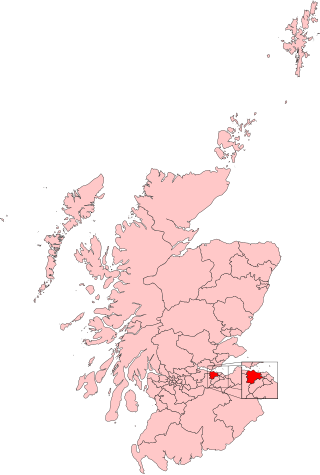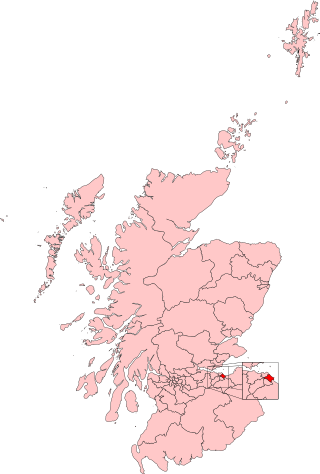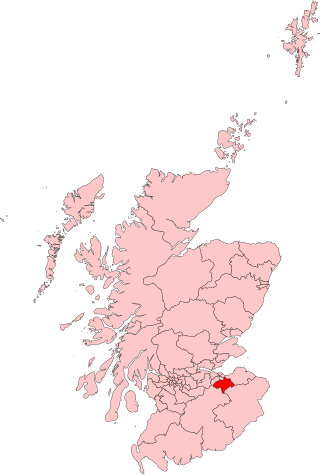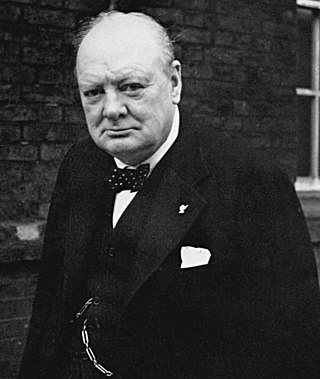
Midlothian is a historic county, registration county, lieutenancy area and one of 32 council areas of Scotland used for local government. Midlothian lies in the east-central Lowlands, bordering the City of Edinburgh council area, East Lothian and the Scottish Borders.

Ettrick and Lauderdale was one of four local government districts in the Borders region of Scotland as well as a lieutenancy area from 1975 to 1996.

Edinburgh West is a burgh constituency of the House of Commons of the Parliament of the United Kingdom, first contested at the 1885 general election.

Edinburgh East is a burgh constituency of the House of Commons of the Parliament of the United Kingdom. It elects one Member of Parliament (MP) by the first past the post system of election.
Edinburgh Leith was a burgh constituency of the House of Commons of the Parliament of the United Kingdom from 1950 to 1997. It elected one Member of Parliament (MP) by the first past the post system of election.

Midlothian in Scotland is a county constituency of the House of Commons of the Parliament of the United Kingdom. It elects one Member of Parliament (MP) by the first-past-the-post voting system.
Edinburghshire was a Scottish county constituency of the House of Commons of the Parliament of Great Britain from 1708 to 1801 and of the Parliament of the United Kingdom from 1801 to 1918.

Scottish Westminster constituencies were Scottish constituencies of the House of Commons of the Parliament of Great Britain, normally at the Palace of Westminster, from 1708 to 1801, and have been constituencies of the House of Commons of the Parliament of the United Kingdom, also at Westminster, since 1801. Constituency boundaries have changed on various occasions, and are now subject to both periodical and ad hoc reviews of the Boundary Commission for Scotland.

Midlothian Council is the local authority for Midlothian, one of the 32 council areas of Scotland, covering an area immediately south of the city of Edinburgh. The council is based in Dalkeith. Since the last boundary changes in 2017, eighteen councillors have been elected from six wards.

Under the Representation of the People Act 1948 and the House of Commons Act 1949 new constituency boundaries were defined and first used in the 1950 general election of the House of Commons of the Parliament of the United Kingdom (Westminster).

The results of the First Periodical Review of the Boundary Commission for Scotland became effective for the 1955 general election of the House of Commons of the Parliament of the United Kingdom (Westminster). The review defined 32 burgh constituencies (BCs) and 39 county constituencies (CCs), with each electing one Member of Parliament (MP) by the first past the post system of election. Therefore, Scotland had 71 parliamentary seats.

Elections in England and Wales, 1949 held during the week of 4–9 April for County Council positions, resulted in sweeping Conservative gains and correspondingly heavy Labour losses. A remarkable feature of the elections was the "dead heat" in the London County Council between Labour and the Conservatives, who each won 64 seats, with the Liberals retaining one seat, that of Sir Percy Harris in Bethnal Green. Outside London, Labour lost its former control of Middlesex, Essex, Northumberland, and the West Riding of Yorkshire; retained control of Derbyshire, Durham, Glamorgan, Monmouthshire, and Nottinghamshire, but won Carmarthenshire, the only county gained by Labour.

Elections to Midlothian Council were held on 3 May 2007, the same day as the other Scottish local government elections and the Scottish Parliament general election. The election was the first one using six new wards created as a result of the Local Governance (Scotland) Act 2004. Each ward will elect three or four councillors using the single transferable vote system form of proportional representation. The new wards replace 18 single-member wards which used the plurality system of election.

Ettrick, Roxburgh and Berwickshire is a constituency of the Scottish Parliament (Holyrood) covering part of the council area of Scottish Borders. It elects one Member of the Scottish Parliament (MSP) by the plurality method of election. It is also one of nine constituencies in the South Scotland electoral region, which elects seven additional members, in addition to the nine constituency MSPs, to produce a form of proportional representation for the region as a whole.

Midlothian North and Musselburgh is a constituency of the Scottish Parliament (Holyrood) covering parts of the council areas of Midlothian and East Lothian. It elects one Member of the Scottish Parliament (MSP) by the plurality method of election. It is one of nine constituencies in the Lothian electoral region, which elects seven additional members, in addition to the nine constituency MSPs, to produce a form of proportional representation for the region as a whole.

Midlothian South, Tweeddale and Lauderdale is a constituency of the Scottish Parliament (Holyrood) covering parts of the council areas of Midlothian and Scottish Borders. Created for the 2011 election, it elects one Member of the Scottish Parliament (MSP) by the plurality method of election. It is one of nine constituencies in the South Scotland electoral region, which elects seven additional members, in addition to nine constituency MSPs, to produce a form of proportional representation for the region as a whole.

The 2012 Midlothian Council election took place on 3 May 2012 to elect members of Midlothian Council. The election used the six wards created as a result of the Local Governance (Scotland) Act 2004, with each ward electing three or four Councillors using the single transferable vote system form of proportional representation, with 18 Councillors being elected.

Elections to Kesteven County Council were held on Saturday, 9 April 1949. Kesteven was one of three divisions of the historic county of Lincolnshire in England; it consisted of the ancient wapentakes of Aswardhurn, Aveland, Beltisloe, Boothby Graffoe, Flaxwell, Langoe, Loveden, Ness, and Winnibriggs and Threo. The Local Government Act 1888 established Kesteven as an administrative county, governed by a Council; elections were held every three years from 1889, until it was abolished by the Local Government Act 1972, which established Lincolnshire County Council in its place.

Elections to Midlothian County Council were held on 10 May 1961. Midlothian was one of the four divisions that made up the historic region of Lothian in Scotland. The Local Government (Scotland) Act 1889 established Midlothian as an administrative county, governed by a County Council.

Elections to Midlothian Council were held on 1 May 2003, the same day as the other Scottish local government elections and the Scottish Parliament general election. The election was the last one using the 18 single-member wards using the plurality system of election.


















